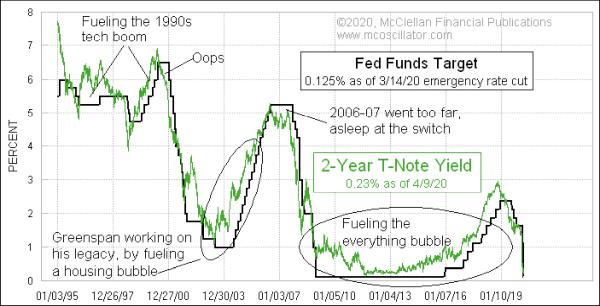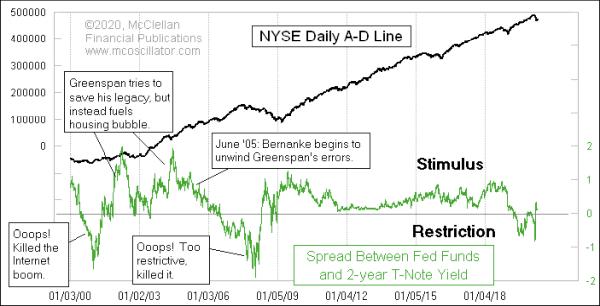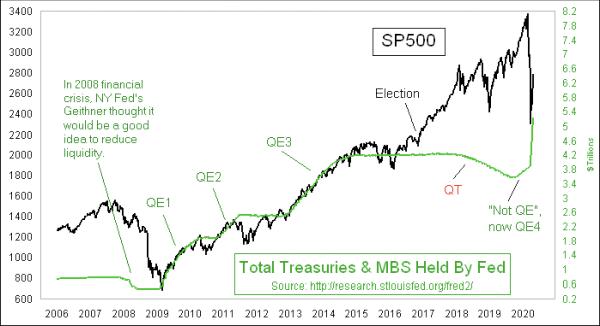
You can put aside your fancy chart patterns and your in-depth fundamental analyses. The Fed is now in charge of everything, and the Fed is buying. As the late Martin Zweig advised, "Don't fight the Fed."
After 10 years of having stimulative interest rate policy, the Fed started having restrictive short-term rates. We say that based on a comparison between the Fed Funds target rate and the 2-year T-Note yield, shown in the chart above. The 2-year T-Note yield is the best guide for where the Fed should set its interest rate target. In fact, we ought to outsource interest rate policy to the 2-year T-Note yield, saving on meeting costs for the FOMC.
In March 2019, the 2-year dropped below the Fed Funds target rate. So, even though there was no real action by the Fed then, the Fed still shifted to a tightening rate policy. The FOMC finally woke up and started cutting rates as of the July 31, 2019 meeting, but they were behind the power curve since the 2-year yield kept on falling.
The FOMC finally took care of that problem of being behind with its emergency rate cut to zero, at an unannounced weekend meeting held on Saturday, March 14. And Chairman Powell stated in an April 9 CNBC interview that the Fed would keep rates there until they are confident that the economy has recovered.
Getting the Fed Funds target rate back down below the 2-year T-Note yield puts the Fed back into stimulative mode. Here is a chart showing the spread between those two and compared to the NYSE A-D Line. The A-D Line tends to do much better when there is a positive spread, meaning that the 2-year yield is above the Fed Funds target.

Having fired all of its guns on interest rate policy, the Fed is turning to other avenues to help stimulate the economy. It has resumed "quantitative easing," or QE, meaning purchases of Treasury debt and mortgage-backed securities (MBS). They are doing these purchases at a greater rate than ever before. And, on April 9, the Fed announced a new $2.3 trillion package of purchases of all sorts of things, including municipal bonds, corporate bond ETFs and even junk bonds. The junk bonds they will purchase are said to only be from companies downgraded to junk ratings after March 22.
Why that date? It could have something to do with the fact that Ford Motor Company (NYSE:F) was downgraded on March 24.
The Fed has apparently learned its lesson from the 2008 financial crisis, when it was slow to act and its first actions were bad.

In mid-2008, the Fed actually reduced its holdings of Treasury debt, which harmed banking system liquidity. They reportedly invested the proceeds into other sorts of programs, but that was not helpful. The market finally made an important and lasting bottom in March 2009, when the Fed commenced purchasing Treasuries again in what came to be known as QE1. That month was also when accounting rules were changed, such that banks did not have to continue the "mark to market" downgrades of its bond assets.
QE1 worked great for lifting the stock market, until it was stopped in early 2010. The May 2010 Flash Crash was the result of that sudden stop in the flow of liquidity.
So the Fed started up again with QE2 beginning in August 2010, and it worked great for lifting the stock market until it was stopped in June 2011. A 19% stock market decline ensued in July 2011.
The Fed got smarter when it did QE3, keeping it going longer, then "tapering" when it started stopping that program. There was no sudden illiquidity event like the 2010 Flash Crash, but the market still had some liquidity problems in late 2015 and early 2016. And when the Fed started actively reducing its holdings in late 2017, we got the wild and illiquid price swings of 2018.
The Fed got back to doing QE again starting in October 2019, and now, thanks to COVID-19, it has sped up those purchases. As with QE1, 2 and 3, it is working to lift stock prices. It should continue doing so for however long the Fed keeps doing it. And then, once the Fed tries to stop this latest round of QE, we should expect that we will experience illiquidity problems once again. How the Fed will ultimately extricate itself from this intervention is an interesting question, but not a relevant one right now for investors. For now, it is an open bar at the party, and the Fed is buying.
